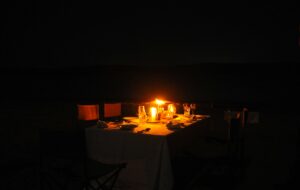Back to basics
 The crackle of the camp fire, a star-studded sky and just a mosquito net between you and Africa’s great wilderness – that’s the magic of fly camping. It’s about stripping away a lot of the safari paraphernalia and enjoying a true wilderness experience away from the main camp.
The crackle of the camp fire, a star-studded sky and just a mosquito net between you and Africa’s great wilderness – that’s the magic of fly camping. It’s about stripping away a lot of the safari paraphernalia and enjoying a true wilderness experience away from the main camp.
Fly camping is usually combined with a walking safari – you arrive at the fly camp either on foot or following your afternoon drive, sometime before sunset.
Camp staff will be waiting for you – and the camp is set up, ready. We had a dome tent alongside a simple mosquito net cube with a comfortable roll mat and bedding within. The dome tent is there in case of rain, to store your belongings and for some privacy when getting changed. You sleep in the cube with a panoramic view of the lake and stars and the sounds of the African bush all around you.
Wash-room facilities are also organised with a short-drop loo and a bucket shower.
Arriving in the last rays of light, there is time to have a good look around camp before enjoying the sunset and a visit to the safari bar. Our tip is to ask for a tour of the camp kitchen before nightfall – it always amazes me what delicious meals the team turn out from cooking in the dark over an open fire and with a simple cast iron stove.
The warm glow of sunset is the perfect backdrop for watching African skimmers. Nightfall comes quickly along with the haunting yowl of hyena and the snort of hippo. This is when it starts to get exciting!
Sit back and enjoy ‘bush TV’ – the camp fire – in the knowledge that your expert guide and an armed ranger are keeping watch. During dinner, our guide, Deo was quick to spot hyenas, lurking in the shadows not far from the wash-room. They sloped off pretty quickly, however their brief appearance made the middle-of-the-night visit to the loo a little more interesting …the advice was to shine the torch all around, have a good look for eye-shine, listen and then proceed. We also heard elephants during our sleep-out and hippo provided a constant soundtrack as they left the lake to graze.
In the morning, wake up bathed in golden light, surrounded by the sounds of Africa and the smell of coffee and cooked breakfast. Watch the hippos as their trail out of the bush back to the lake, while keeping half an eye on the antics of yellow-billed stalks and fish eagles.
After breakfast, we headed off on foot with our guide – the itinerary will vary depending where you are. Our very hot and sweaty walk of around 5-6km concluded at a hot spring. While on foot we saw buffalo, giraffe, hippo of course, and a crocodile at very close quarters. It was a wonderful opportunity to learn more about tracking in the bush, and for Deo to share his wide knowledge of not only the fauna but the flora of the park, from showing us whistling acacia to wild onions (a favourite snack for porcupines apparently). After a dip in the hotsprings and a quick change behind a large boulder, we returned to the vehicle for cold drinks and a game drive back to the idyllic main camp, Sand Rivers.
Fly camping is the ultimate African bush experience. It may seem like madness to leave the comfort and luxury of the main camp for a night’s sleepout, but if you enjoy an adventure and want to connect with nature at a whole new level, then go for it – you’ll feel truly invigorated. I firmly believe it will be the best thing you do.
Sara stayed at Sand Rivers in Nyerere National Park, Tanzania. The fly-camp was based at Lake Tagalala. If you’re interested in incorporating fly-camping or a star-bed /treehouse or sleep-out experience during your safari then please do ask us for advice – there are lots of exciting options!
See sample itinerary featuring Sand Rivers here.











